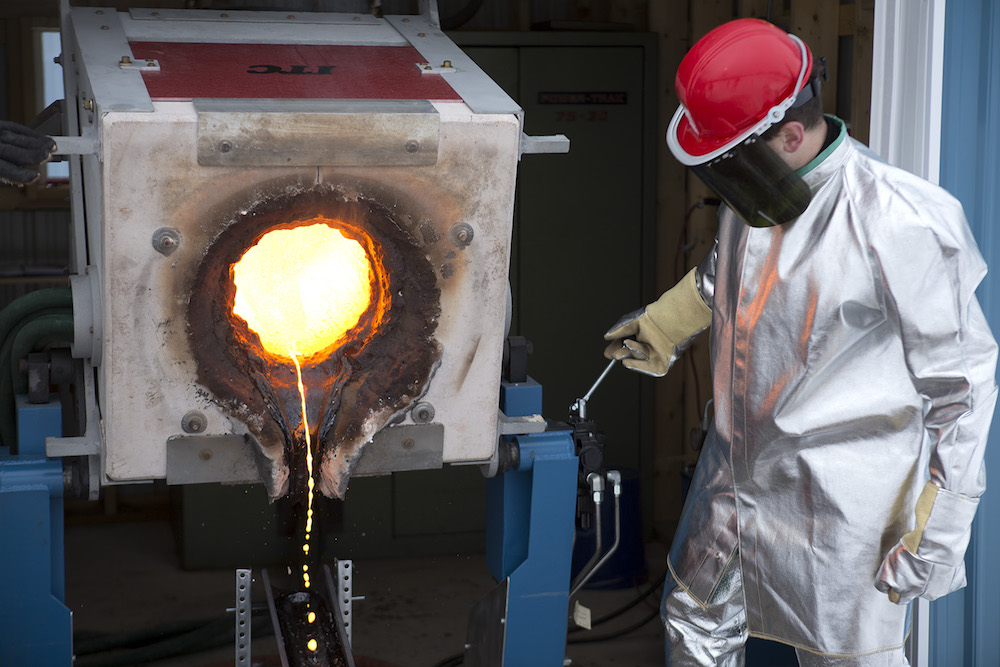
Scientists are mixing up a batch of home-brew lava in order to blow it all up.
The plan involves melting gallons of solid rock in a superpowered furnace, pouring it out, and then dousing the molten rock with water and watching the sparks fly (or not).
The fake lava is intended to help scientists answer a serious question: What exactly happens when the oozing, hot rock meets water, as occurs in places like Iceland? [See Images of the Home-Brew Lava Experiment]
"The eruption at Eyjafjallajökull was more explosive due to the presence of water," Ingo Sonder, the geologist at the University at Buffalo in New York who is leading the project, said in a statement. "Events like that don't happen often, but there is a threat of a big impact when they do. As geologists, we want to understand the conditions that generate explosions — how much water do you need? How much time?"
Little-understood
While the explosive combination of fire and ice has formed many places on Earth, relatively little is understood about the process. For instance, Hunt's Hole in New Mexico was formed when water and lava interacted, creating a maar crater. Ice-bound volcanoes such as Eyjafjallajökull may also experience supercharged explosions as a result of the interaction. That's because when water turns to steam, its volume expands a thousandfold, James Beget, a volcanologist at the Alaska Volcano Observatory and the University of Alaska, Fairbanks, who was not involved in the current study, previously told Live Science.
On the other hand, sometimes the lava-water reaction simply fizzles out and nothing happens at all, researchers said. [The Biggest and Weirdest Maars on Earth]
Homebrew lava fields
To understand why certain rock-and-water interactions are so explosive, Sonder and his colleagues will heat 10-gallon (38 liters) batches of basaltic rock to 2,500 degrees Fahrenheit (1371 degrees Celsius) in a furnace. They will then pour the oozing mass out into 4-foot-long (1.2 meters) tubes that mimic the subterranean rivers of lava found beneath volcanoes. The experimenters will put on spacesuit-like reflective outfits to shield themselves from the intense heat of the lava before they inject water into the tubes at a geohazards field station in Ashford, New York.
Get the world’s most fascinating discoveries delivered straight to your inbox.
As the water and lava meet, microphones, thermal cameras, and temperature and pressure sensors will help scientists piece together exactly what happened. The team plans to conduct the same experiments dozens of times.
Sonder has worked on similar experiments with a coffee cup's worth of lava, but the team suspects that those desktop experiments didn't resolve the underlying question, Sonder said.
"No one has done it before on this scale, and these lava-water interactions aren't well understood," said Alison Graettinger, a geologist at the University at Buffalo who is also involved in the experiment. "Sometimes when water and lava meet, the lava will appear to completely ignore the water. Sometimes, the lava will cool and form distinctive cracking patterns, or form interesting shapes like pillow lavas. And sometimes, the reaction is violent. Why?"
Original article on Live Science.

Tia is the editor-in-chief (premium) and was formerly managing editor and senior writer for Live Science. Her work has appeared in Scientific American, Wired.com, Science News and other outlets. She holds a master's degree in bioengineering from the University of Washington, a graduate certificate in science writing from UC Santa Cruz and a bachelor's degree in mechanical engineering from the University of Texas at Austin. Tia was part of a team at the Milwaukee Journal Sentinel that published the Empty Cradles series on preterm births, which won multiple awards, including the 2012 Casey Medal for Meritorious Journalism.


